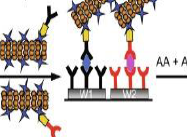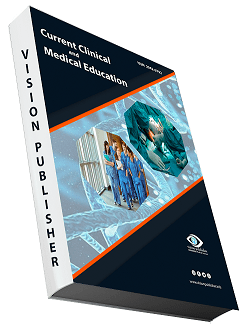Electrochemical Immunosensors, Electrochemical Detection Techniques, Methods and Application of Microfluidics in Immunoassay
Keywords:
Microfluidics in Immunoassay, Electrochemical Immunosensors, Detection, Techniques, ApplicationAbstract
The use of electrochemical methods for purifying and separating wastewater has recently attracted a lot of interest. Since electrons are the primary reagent and they do not generate solid residue, they are considered cleaner than numerous other physiochemical and membrane-based technologies. In addition, the rapid response time, great selectivity, dependability, and sensitivity of electrochemical techniques have made them attractive as tools for water treatment. These methods have progressed to the point where they are not only efficient and small, but also inexpensive. The environmental contamination caused by perchlorate, nitrate, and other salts is a big problem because these substances are widely utilised as rocket and missile propellants and in other industrial applications. Since the problem of environmental contaminations is becoming worse by the day, effective methods of removing these species are urgently required. After reviewing the literature, it is clear that in order to effectively remove species like perchlorate and nitrate on an industrial scale, a new electrochemical reduction method utilising selective electrocatalysts following a stable mechanistic path is necessary. Among the many difficult problems with electrochemical reduction techniques is the requirement to develop economically viable or cost-effective processes. In addition, photo-electrochemical techniques are still in the early stages of study, thus further in-depth investigations are needed to fully understand their potential. It is also difficult to detect these ions in water. Therefore, additional study is needed to develop effective methods for detecting nitrate and perchlorate. Molecular diagnostics, immunoassays, and biochemical analyses have all benefited greatly from point-of-care testing in recent years, particularly in areas with limited access to laboratory facilities. Microfluidic chips offer numerous notable benefits over other point-of-care testing technologies. All steps of a biological reaction—from loading reagents to detecting their presence—can be carried out on a single microprocessor thanks to technology that miniaturises traditional laboratory equipment. This has led to the microfluidic platform being extensively studied in recent decades for applications in environmental monitoring, healthcare, and food safety. In this article, we will take a look back at the most recent developments in the use of microfluidics in immunoassay. There are two components to a microfluidic platform, passive manipulation and active manipulation, that are based on the various fluid driving forces. Active manipulation encompasses the introduction of pressure, centrifugal, electric, optofluidic, magnetic, and digital microfluidics; passive manipulation centres on capillary-driven microfluidics.
Downloads
References
N. M. Pham, S. Rusch, Y. Temiz, H. P. Beck, W. Karlen, and E. Delamarche, “Immuno-gold silver staining assays on capillary-driven microfluidics for the detection of malaria antigens,” Biomedical Microdevices, vol. 21, no. 1, 2019.
Y.-H. Lin, C. C. Wu, W. L. Chen, and K. P. Chang, “Anti-p53 autoantibody detection in automatic glass capillary immunoassay platform for screening of oral cavity squamous cell carcinoma,” Sensors, vol. 20, no. 4, 2020.
K. Kadimisetty, I. M. Mosa, S. Malla et al., “3D-printed supercapacitor-powered electrochemiluminescent protein immunoarray,” Biosensors and Bioelectronics, vol. 77, pp. 188–193, 2016
A. M. Schrell, N. Mukhitov, L. Yi, J. E. Adablah, J. Menezes, and M. G. Roper, “Online fluorescence anisotropy immunoassay for monitoring insulin secretion from islets of Langerhans,” Analytical Methods, vol. 9, no. 1, pp. 38–45, 2017.
H. Li, J. V. Sorensen, and K. V. Gothelf, “Quantitative detection of digoxin in plasma using small-molecule immunoassay in a recyclable gravity-driven microfluidic chip,” Advanced Science, vol. 6, no. 6, 2019.
D. Wu, J. Zhang, F. Xu et al., “A paper-based microfluidic Dot-ELISA system with smartphone for the detection of influenza A,” Microfluidics and Nanofluidics, vol. 21, no. 3, 2017.
R. Gorkin, J. Park, J. Siegrist et al., “Centrifugal microfluidics for biomedical applications,” Lab on a Chip, vol. 10, no. 14, pp. 1758–1773, 2010. [26] B. S. Lee, Y. U. Lee, H.-S. Kim et al., “Fully integrated lab-ona-disc for simultaneous analysis of biochemistry and immunoassay from whole blood,” Lab Chip, vol. 11, no. 1, pp. 70–78, 2011.
Z. Noroozi, H. Kido, R. Peytavi et al., “A multiplexed immunoassay system based upon reciprocating centrifugal microfluidics,” Review of Scientific Instruments, vol. 82, no. 6, 2011.
T.-H. Kim, K. Abi-Samra, V. Sunkara et al., “Flow-enhanced electrochemical immunosensors on centrifugal microfluidic platforms,” Lab on a Chip, vol. 13, no. 18, pp. 3747–3754, 2013.
E. M. Arjmand, M. Saadatmand, M. R. Bakhtiari, and M. Eghbal, “Design and fabrication of a centrifugal microfluidic disc including septum valve for measuring hemoglobin A1c in human whole blood using immunoturbidimetry method,” Talanta, vol. 190, pp. 134– 139, 2018.
C. M. Miyazaki, D. J. Kinahan, R. Mishra et al., “Label-free, spatially multiplexed SPR detection of immunoassays on a highly integrated centrifugal lab-on-a-disc platform,” Biosensors and Bioelectronics, vol. 119, pp. 86–93, 2018.
C. R. Phaneuf, B. Mangadu, H. M. Tran et al., “Integrated LAMP and immunoassay platform for diarrheal disease detection,” Biosensors and Bioelectronics, vol. 120, pp. 93– 101, 2018.
M. M. Aeinehvand, L. Weber, M. Jimenez et al., “Elastic ´ reversible valves on centrifugal microfluidic platforms,” Lab on a Chip, vol. 19, no. 6, pp. 1090–1100, 2019.
Z. Gao, Z. Chen, J. Deng et al., “Measurement of carcinoembryonic antigen in clinical serum samples using a centrifugal microfluidic device,” Micromachines, vol. 9, no. 9, p. 470, 2018.
Q. Lin, J. Wu, X. Fang, and J. Kong, “Washing-free centrifugal microchip fluorescence immunoassay for rapid and point-of-care detection of protein,” Analytica Chimica Acta, vol. 1118, pp. 18–25, 2020.
Y. Ukita, S. Kondo, T. Azeta et al., “Stacked centrifugal microfluidic device with three-dimensional microchannel networks and multifunctional capillary bundle structures for immunoassay,” Sensors and Actuators B: Chemical, vol. 166- 167, pp. 898–906, 2012.
K. Wang, R. Liang, H. Chen, S. Lu, S. Jia, and W. Wang, “A microfluidic immunoassay system on a centrifugal platform,” Sensors and Actuators B: Chemical, vol. 251, pp. 242–249, 2017.
S. Lutz, E. Lopez-Calle, P. Espindola et al., “A fully integrated microfluidic platform for highly sensitive analysis of immunochemical parameters,” ?e Analyst, vol. 142, no. 22, pp. 4206–4214, 2017.
S. Okamoto and Y. Ukita, “Automatic microfluidic enzymelinked immunosorbent assay based on CLOCK-controlled autonomous centrifugal microfluidics,” Sensors and Actuators B: Chemical, vol. 261, pp. 264–270, 2018.
T. Abe, S. Okamoto, A. Taniguchi et al., “A lab in a bento box: an autonomous centrifugal microfluidic system for an enzyme-linked immunosorbent assay,” Analytical Methods, vol. 12, no. 40, pp. 4858–4866, 2020.
G. Czilwik, S. K. Vashist, V. Klein et al., “Magnetic chemiluminescent immunoassay for human C-reactive protein on the centrifugal microfluidics platform,” RSC Advances, vol. 5, no. 76, Article ID 61906, 2015.
Y. Zhao, G. Czilwik, V. Klein, K. Mitsakakis, R. Zengerle, and N. Paust, “C-reactive protein and interleukin 6 microfluidic immunoassays with on-chip pre-stored reagents and centrifugo-pneumatic liquid control,” Lab on a Chip, vol. 17, no. 9, pp. 1666–1677, 2017.
M. Shen, N. Li, Y. Lu, J. Cheng, and Y. Xu, “An enhanced centrifugation-assisted lateral flow immunoassay for the point-of-care detection of protein biomarkers,” Lab on a Chip, vol. 20, no. 15, pp. 2626–2634, 2020.
J. Siegrist, R. Gorkin, L. Clime et al., “Serial siphon valving for centrifugal microfluidic platforms,” Microfluidics and Nanofluidics, vol. 9, no. 1, pp. 55–63, 2010.
X. Meng, Y. Zhu, Y. Chen, Y. Lu, Y. Xu, and J. Cheng, “Conditional siphon priming for multi-step assays on centrifugal microfluidic platforms,” Sensors and Actuators B: Chemical, vol. 242, pp. 710–717, 2017.
S. Lai, S. Wang, J. Luo, L. J. Lee, S.-T. Yang, and M. J. Madou, “Design of a compact disk-like microfluidic platform for enzyme-linked immunosorbent assay,” Analytical Chemistry, vol. 76, no. 7, pp. 1832–1837, 2004.
S. Guo, R. Ishimatsu, K. Nakano, and T. Imato, “Automated chemiluminescence immunoassay for a nonionic surfactant using a recycled spinning-pausing controlled washing procedure on a compact disc-type microfluidic platform,” Talanta, vol. 133, pp. 100–106, 2015.
Z. Cai, J. Xiang, B. Zhang, and W. Wang, “A magnetically actuated valve for centrifugal microfluidic applications,” Sensors and Actuators B: Chemical, vol. 206, pp. 22–29, 2015.
Z. Cai, J. Xiang, H. Chen, and W. Wang, “Membrane-based valves and inward-pumping system for centrifugal microfluidic platforms,” Sensors and Actuators B: Chemical, vol. 228, pp. 251–258, 2016.
A. van Reenen, A. M. de Jong, J. M. J. den Toonder, and M. W. J. Prins, “Integrated lab-on-chip biosensing systems based on magnetic particle actuation - a comprehensive review,” Lab Chip, vol. 14, no. 12, pp. 1966–1986, 2014.
H. C. Tekin and M. A. M. Gijs, “Ultrasensitive protein detection: a case for microfluidic magnetic bead-based assays,” Lab on a Chip, vol. 13, no. 24, pp. 4711–4739, 2013.
K. S. Kim and J.-K. Park, “Magnetic force-based multiplexed immunoassay using superparamagnetic nanoparticles in microfluidic channel,” Lab on a Chip, vol. 5, no. 6, pp. 657–664, 2005.
K. Hoshino, Y.-Y. Huang, N. Lane et al., “Microchip-based immunomagnetic detection of circulating tumor cells,” Lab on a Chip, vol. 11, no. 20, pp. 3449–3457, 2011.
X. Guo, “Fe3O4@Au nanoparticles enhanced surface plasmon resonance for ultrasensitive immunoassay,” Sensors and Actuators B: Chemical, vol. 205, pp. 276–280, 2014.
Ali,H,A&Ahmed,O.H.(2019). lmmunohistologicar Study of ER, pR, and Fler2lneu status in Breast carcinoma. Indian J. Public Hralth Research & Development.Vol 10,No 9.
Haneen Imad Al-Sultani1, Ahmed Obaid Hussain, Hazar Shakir Saleh(2023) Histophysiological Effect of Rosuvastatin on the Kidney in Male Albino Rats. Adv. Anim. Vet. Sci., Vol 11 : 12
Ahmed Obaid Hossain,(2018). Histological Effect of Androgenic Anabolic Steroide Dianabol in Heart and Some Blood Parameters of Male Albino Rats . J. Global Pharma Tech.| 2018; 10(03): 215-219
Ahmed Obaid Hossain, Zahraa Majid Abed Alameer, Khansaa Hatteam,(2018). Adequacy of Magnetic Resonance Image versus Electromyography in Patients with Back Pain. J. Global Pharma Tech.| 2018; 10(03): 225-228
Ali Hassan Al-Timimi, Ahmed Obaid Hossain,(2018). Molecular Identification of Entamoeba Histolytica In Amoebiasis Patients. J. Global Pharma Tech.| 2018; Vol.10 Issue 10 (Suppl.):403-407
Y. Lin, Q. Zhou, D. Tang, R. Niessner, and D. Knopp, “Signal-on photoelectrochemical immunoassay for aflatoxin B1 based on enzymatic product-etching MnO2 nanosheets for dissociation of carbon dots,” Analytical Chemistry, vol. 89, no. 10, pp. 5637–5645, 2017.
M. Sharafeldin, G. W. Bishop, S. Bhakta, A. El-Sawy, S. L. Suib, and J. F. Rusling, “Fe3O4 nanoparticles on graphene oxide sheets for isolation and ultrasensitive amperometric detection of cancer biomarker proteins,” Biosensors and Bioelectronics, vol. 91, pp. 359–366, 2017.
Qiu, J., Jiang, P., Wang, C., Chu, Y., Zhang, Y., Wang, Y., et al. (2022). Lys-AuNPs@MoS(2) nanocomposite self-assembled microfluidic immunoassay biochipfor ultrasensitive detection of multiplex biomarkers for cardiovascular diseases.
Anal. Chem. 94 (11), 4720–4728. Qiu, X., Li, Y., Wang, Y., Guo, H., and Nie, L. (2020). A novel molecularlyimprinted nanosensor based on quartz crystal microbalance for specific recognitionof α-amanitin. Microchem. J. 159, 105383.
Regiart, M., Gimenez, A. M., Lopes, A. T., Carreno, M. N. P., and Bertotti, M.(2020). Ultrasensitive microfluidic electrochemical immunosensor based onelectrodeposited nanoporous gold for SOX-2 determination. Anal. Chim. Acta1127, 122–130.
doi:10.1016/j.aca.2020.06.037
Reis, N. M., Needs, S. H., Jegouic, S. M., Gill, K. K., Sirivisoot, S., Howard, S., et al.(2021). Gravity-driven microfluidic siphons: Fluidic characterization andapplication to quantitative immunoassays. ACS Sens. 6 (12), 4338–4348.
Rodriguez-Moncayo, R., Cedillo-Alcantar, D. F., Guevara-Pantoja, P. E., Chavez-Pineda, O. G., Hernandez-Ortiz, J. A., Amador-Hernandez, J. U., et al. (2021). Ahigh-throughput multiplexed microfluidic device for COVID-19 serology assays.Lab. Chip 21 (1), 93–104.
Ruecha, N., Shin, K., Chailapakul, O., and Rodthongkum, N. (2019). Label-freepaper-based electrochemical impedance immunosensor for human interferon gammadetection. Sens. Actuators B Chem. 279, 298–304. doi:10.1016/j.snb.2018.10.024
Sackmann, E. K., Fulton, A. L., and Beebe, D. J. (2014). The present and futurerole of microfluidics in biomedical research. Nature 507 (7491), 181–189.
Schmidt-Speicher, L. M., and Länge, K. (2021). Microfluidic integration forelectrochemical biosensor applications. Curr. Opin. Electrochem. 29, 100755.doi:10.1016/j.coelec.2021.100755
Singh, A., Malek, C. K., and Kulkarni, S. K. (2011). Development in microreactortechnology for nanoparticle synthesis. IJN 09, 93–112. doi:10.1142/s0219581x10006557
Sista, R. S., Eckhardt, A. E., Srinivasan, V., Pollack, M. G., Palanki, S., andPamula, V. K. (2008). Heterogeneous immunoassays using magnetic beads on adigital microfluidic platform. Lab. Chip 8 (12), 2188–2196. doi:10.1039/b807855f
Sticker, D., Geczy, R., Hafeli, U. O., and Kutter, J. P. (2020). Thiol-ene basedpolymers as versatile materials for microfluidic devices for life sciences applications.ACS Appl. Mater Interfaces 12 (9), 10080–10095. doi:10.1021/acsami.9b22050
Sun, L., Lehnert, T., Li, S., and Gijs, M. A. M. (2022). Bubble-enhanced ultrasonicmicrofluidic chip for rapid DNA fragmentation. Lab. Chip 22 (3), 560–572. doi:10.1039/d1lc00933h
Syed, A., Mangano, L., Mao, P., Han, J., and Song, Y. A. (2014). Creating sub-50nm nanofluidic junctions in a PDMS microchip via self-assembly process ofcolloidal silica beads for electrokinetic concentration of biomolecules. Lab. Chip14 (23), 4455–4460. doi:10.1039/c4lc00895b
Tan, H., Gong, G., Xie, S., Song, Y., Zhang, C., Li, N., et al. (2019). UpconversionNanoparticles@Carbon Dots@Meso-SiO(2) sandwiched core-shell nanohybridswith tunable dual-mode luminescence for 3D anti-counterfeiting barcodes.Langmuir 35 (35), 11503–11511. doi:10.1021/acs.langmuir.9b01919
Tang, T., Yuan, Y., Yalikun, Y., Hosokawa, Y., Li, M., and Tanaka, Y. (2021).Glass based micro total analysis systems: Materials, fabrication methods, andapplications. Sens. Actuators B Chem. 339, 129859. doi:10.1016/j.snb.2021.129859
van de Sandt, C. E., Kreijtz, J. H., and Rimmelzwaan, G. F. (2012). Evasion ofinfluenza A viruses from innate and adaptive immune responses. Viruses 4 (9),1438–1476. doi:10.3390/v4091438
Vera, D., Garcia-Diaz, M., Torras, N., Alvarez, M., Villa, R., and Martinez,E. (2021). Engineering tissue barrier models on hydrogel microfluidicplatforms. ACS Appl. Mater Interfaces 13 (12), 13920–13933. doi:10.1021/acsami.0c21573
Vergauwe, N., Witters, D., Ceyssens, F., Vermeir, S., Verbruggen, B., Puers, R.,et al. (2011). A versatile electrowetting-based digital microfluidic platform forquantitative homogeneous and heterogeneous bio-assays. J. Micromech. Microeng.21 (5), 054026. doi:10.1088/0960-1317/21/5/054026
Wang, H., Enders, A., Preuss, J. A., Bahnemann, J., Heisterkamp, A., and Torres-Mapa, M. L. (2021a). 3D printed microfluidic lab-on-a-chip device for fiber-baseddual beam optical manipulation. Sci. Rep. 11 (1), 14584. doi:10.1038/s41598-021-93205-9
Wang, X., He, X., He, Z., Hou, L., Ge, C., Wang, L., et al. (2022). Detection ofprostate specific antigen in whole blood by microfluidic chip integrated withdielectrophoretic separation and electrochemical sensing. Biosens. Bioelectron.204, 114057. doi:10.1016/j.bios.2022.114057
Wang, Y., Ruan, Q., Lei, Z. C., Lin, S. C., Zhu, Z., Zhou, L., et al. (2018). Highlysensitive and automated surface enhanced Raman scattering-based immunoassayfor H5N1 detection with digital microfluidics. Anal. Chem. 90 (8), 5224–5231.doi:10.1021/acs.analchem.8b00002
Wang, Y., Zhao, J., Zhu, Y., Dong, S., Liu, Y., Sun, Y., et al. (2021b).Monolithic integration of nanorod arrays on microfluidic chips for fast andsensitive one-step immunoassays. Microsyst. Nanoeng. 7, 65. doi:10.1038/s41378-021-00291-w
Wang, Z., Zong, S., Wu, L., Zhu, D., and Cui, Y. (2017). SERS-activated platformsfor immunoassay: Probes, encoding methods, and applications. Chem. Rev. 117(12), 7910–7963. doi:10.1021/acs.chemrev.7b00027
Wu, D., Luo, Y., Zhou, X., Dai, Z., and Lin, B. (2005). Multilayer poly(vinylalcohol)-adsorbed coating on poly(dimethylsiloxane) microfluidic chips forbiopolymer separation. Electrophoresis 26 (1), 211–218. doi:10.1002/elps.200406157
R. R. G. Soares, D. R. Santos, V. Chu, A. M. Azevedo, M. R. Aires-Barros, and J. P. Conde, “A point-of-use microfluidic device with integrated photodetector array for immunoassay multiplexing: detection of a panel of mycotoxins in multiple samples,” Biosensors and Bioelectronics, vol. 87, pp. 823–831, 2017.
G. Ruiz-Vega, K. Arias-Alp´ızar, and E. De La Serna, “Electrochemical POC device for fast malaria quantitative diagnosis in whole blood by using magnetic beads, Poly-HRP and microfluidic paper electrodes,” Biosensors and Bioelectronics, vol. 150, Article ID 111925, 2020.
R. Gao, J. Ko, K. Cha et al., “Fast and sensitive detection of an anthrax biomarker using SERS-based solenoid microfluidic sensor,” Biosensors and Bioelectronics, vol. 72, pp. 230–236, 2015.
L. W. Yap, H. Chen, Y. Gao et al., “Bifunctional plasmonicmagnetic particles for an enhanced microfluidic SERS immunoassay,” Nanoscale, vol. 9, no. 23, pp. 7822–7829, 2017.
D. Liu, Y. Zhang, M. Zhu et al., “Microfluidic-integrated multicolor immunosensor for visual detection of HIV-1 p24 antigen with the naked eye,” Analytical Chemistry, vol. 92, no. 17, Article ID 11826, 2020.
J. Tang, D. Tang, R. Niessner, G. Chen, and D. Knopp, “Magneto-controlled graphene immunosensing platform for simultaneous multiplexed electrochemical immunoassay using distinguishable signal tags,” Analytical Chemistry, vol. 83, no. 13, pp. 5407–5414, 2011.
R. Malhotra, V. Patel, B. V. Chikkaveeraiah et al., “Ultrasensitive detection of cancer biomarkers in the clinic by use of a nanostructured microfluidic array,” Analytical Chemistry, vol. 84, no. 14, pp. 6249–6255, 2012.
R. Yang, F. Li, W. Zhang et al., “Chemiluminescence immunoassays for simultaneous detection of three heart disease biomarkers using magnetic carbon composites and threedimensional microfluidic paper-based device,” Analytical Chemistry, vol. 91, no. 20, Article ID 13006, 2019.
L. Armbrecht, O. Rutschmann, B. M. Szczerba, J. Nikoloff, N. Aceto, and P. S. Dittrich, “Quantification of protein secretion from circulating tumor cells in microfluidic chambers,” Advanced Science, vol. 7, no. 11, 2020.
X. Wen, Y. C. Ou, H. F. Zarick et al., “PRADA: portable reusable accurate diagnostics with nanostar antennas for multiplexed biomarker screening,” Bioengineering & Translational Medicine, vol. 5, no. 3, 2020.
K.W. Chang, J. Li, C.-H. Yang, S.-C. Shiesh, and G.-B. Lee, “An integrated microfluidic system for measurement of glycated hemoglobin levels by using an aptamer-antibody assay on magnetic beads,” Biosensors and Bioelectronics, vol. 68, pp. 397–403, 2015.
R. Gao, Z. Lv, Y. Mao et al., “SERS-based pump-free microfluidic chip for highly sensitive immunoassay of prostate-specific antigen biomarkers,” ACS Sensors, vol. 4, no. 4, pp. 938–943, 2019.
C. Coarsey, B. Coleman, M. A. Kabir, M. Sher, and W. Asghar, “Development of a flow-free magnetic actuation platform for an automated microfluidic ELISA,” RSC Advances, vol. 9, no. 15, pp. 8159–8168, 2019.
Ahmed,Obaid.H.(2019). carbimazole and its effects on th'roid grand of fenrare rabbits. In-dian J Forensic Medicine & Toxicology,Vol13,No.3.
Anfal Ali Shakir,;Ahmed Obaid Hossain; Wasna'a M. Abdulridha and Mohammed Ahmed Mohammed (2017) Toxipathological Effect of Silver Nanoparticles on The Brain and liver of Albino Rats.Int. J. Chem.Tech Res., 2017,10(2): 624-629.13-
Ali Hassan AI-Timimi and Ahmed Obaid Hossain,(2019). Immunohistological Study of ER, PR, and Her2/neu Status in Breast Carcinoma .Indian J. Pub. Health Res.& Dev, Vol.10, No. 6
Ahmed Obaid Hossain,(2019).Carbimazole and its Effects on Thyrod Gland of Female Rabbits Indian J .Foren. Med. & Toxicol., Vol. 13, No. 3

Downloads
Published
How to Cite
Issue
Section
License

This work is licensed under a Creative Commons Attribution 4.0 International License.
Current Clinical and Medical Education













